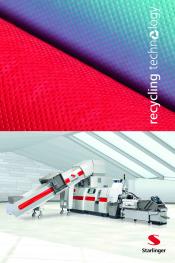plasticker-News
| 2014-02-24, 06:02 |

|
Starlinger: Recycling of nonwoven production scrap
|
At INDEX 14 in Geneva from April 8 -11, 2014, Starlinger recycling technology shows how to turn production scrap into a valuable secondary resource. During the highly complex process of nonwoven fabric production waste occurs along the entire production chain - from start-up waste and off-spec material all the way to conversion scrap. Converting it into a secondary resource can help to cut down production costs by reducing waste and raw material expenses. In-house recycling for better quality control Nonwovens consist of different polymers and polymer mixtures, have different viscosities, and type and amount of contaminations and required filtration fineness vary a lot. Due to the fact that nonwoven production waste comes in different shapes it is usually necessary to recycle it into pellets to make it suitable for reuse. A production stop caused by less than perfect regranulate is costly and jeopardizes the economic benefits of processing and reusing the production scrap. The lack of quality control in case of tolling recycling very often prevents nonwoven producers from using recycled material. In-house recycling, on the other hand, helps a nonwoven manufacturer to control the quality of the regranulate through his own materials management. To ensure the production of high quality regranulate an analysis of the input material and the right choice of equipment is paramount. The recycling systems of Starlinger recycling technology convert nonwoven production scrap into first quality regranulate perfectly fit for reuse, says the company. Vacuum treatment, fine filtration, pelletising To ensure high-quality regranulate, Starlinger recycling systems are equipped with an extruder vacuum unit. According to Starlinger it extracts volatile contaminants - spin finish, for example - and reduces viscosity loss in the melt. A variety of melt filtration systems ensure clean, high-grade melt: melt filters with and without backflushing, power backflush filters and continuous rotation filters are the most common. The choice of filter type and size depends on the type and amount of contaminants. A specially designed cascade filtration system enables very fine filtration down to 25 μm to meet the high requirements in the fiber industry. Starlinger recycling technology provides a wide range of pelletising equipment depending on viscosity, preferred shape of regranulate, and required grade of automatisation. Optionally for PET/PES, crystallisation equipment and solid-stating reactors for IV (intrinsic viscosity) increase are available. All the recycling equipment is permanently set up for trial runs at the Starlinger Technical Center in Weissenbach near Vienna, Austria. Interested companies can compare technologies, process their own materials, and obtain regranulate to test in their production units. More information: www.starlinger.com, www.recycling.starlinger.com Index 14, April 8 -11, 2014, Geneva, Switzerland, Booth 2501 |
Starlinger & Co. GmbH, Vienna, Austria
 back to news list back to news list |  back to top back to top |












